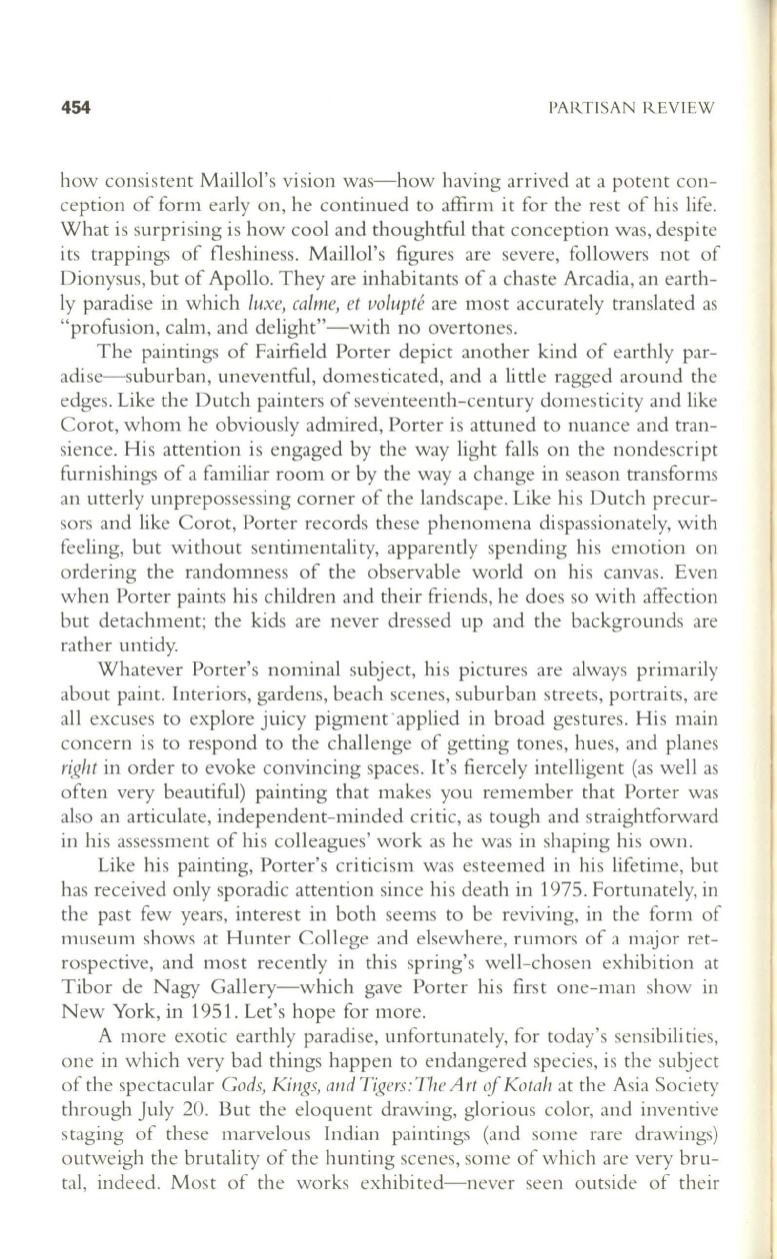
454
PARTISAN REVIEW
how consistent Maillol's vision was-how having arrived at a potent con–
ception of form early on, he continued to affirm it for the rest of his life.
What is surprising is how cool and thoughtful that conception was, despite
its trappings of fleshiness. Maillol's figures are severe, followers not of
Dionysus, but of Apollo. They are inhabitants of a chaste Arcadia, an earth–
ly paradise in which
luxe, caime, et voiupte
are most accurately translated as
"profusion, calm, and delight"-with no overtones.
The paintings of Fairfield Porter depict another kind of earthly par–
adise-suburban, uneventful, domesticated, and a little ragged around the
edges. Like the Dutch painters of seventeenth-century domesticity and like
Corot, whom he obviously admired, Porter is attuned to nuance and tran–
sience. His attention is engaged by the way light falls on the nondescript
furnishings of a familiar room or by the way a change in season transforms
an utterly unprepossessing corner of the landscape. Like his Dutch precur–
sors and like Corot, Porter records these phenomena dispassionately, with
feeling, but without sentimentality, apparently spending his emotion on
ordering the randomness of the observable world on his canvas. Even
when Porter paints his children and their friends, he does so with affection
but detachment; the kids are never dressed up and the backgrounds are
rather untidy.
Whatever Porter's nominal subject, his pictures are always primarily
about paint. Interiors, gardens, beach scenes, suburban streets, portraits, are
all excuses to explore juicy pigment ·applied in broad gestures. His main
concern is to respond to the challenge of getting tones, hues, and planes
right
in order to evoke convincing spaces. It's fiercely intelligent (as well as
often very beautiful) painting that makes you remember that Porter was
also an articulate, independent-minded critic, as tough and straightforward
in his assessment of his colleagues' work as he was in shaping his own.
Like his painting, Porter's criticism was esteemed in his lifetime, but
has received only sporadic attention since his death in 1975. Fortunately, in
the past few years, interest in both seems to be reviving, in the form of
museum shows at Hunter College and elsewhere, rUl110rs of a major ret–
rospective, and most recently in this spring's well-chosen exhibition at
Tibor de Nagy Gallery-which gave Porter his first one-man show in
New York, in 1951. Let's hope for more.
A more exotic earthly paradise, unfortunately, for today's sensibilities,
one in which very bad things happen to endangered species, is the subject
of the spectacular
Gods, Kings, ami Tigers: The Art
oj
Kotah
at the Asia Society
through July
20.
But the eloquent drawing, glorious color, and inventive
staging of these marvelous Indian paintings (and some rare drawings)
outweigh the brutality of the hunting scenes, some of which are very bru–
tal, indeed. Most of the works exhibi ted-never seen outside of their


